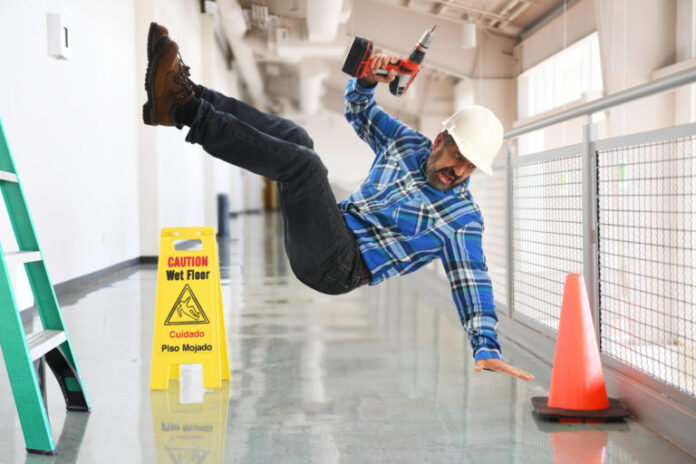It’s impossible to control when an accident occurs in the workplace. Nevertheless, private industry employers reported 2.7 million nonfatal workplace injuries in 2020, a decrease from the previous year.
Stringent health and safety rules can mitigate the risk of injuries in the workplace. Making yourself aware of the different types of work-related injuries will enable you to put in place the measures that protect your employees and the future of your business.
1. Slips, Trips, and Falls

Slips, trips, and falls are constantly rolled into a single category of workplace injury. These are by far the most common types of nonfatal injuries. However, they’re also considered one of the so-called “Fatal Four,” a grouping of workplace accidents commonly leading to death.
Slips, trips, and falls can happen at any time. For example, employees may slip on a wet or oily floor patch, trip over a trailing cable, or fall from a ladder while changing a lightbulb. Most of these injuries can be avoided by paying attention to the fall protection requirements mandated by the Occupational Safety and Health Association (OSHA).
These types of accidents vary wildly in terms of their severity. However, even the most minor accident can lead to your business losing thousands in lost productivity and compensation claims for medical costs.
You must ensure that you have an appropriate workers’ compensation insurance policy that protects your organization. Taking out this type of insurance is a legal requirement in practically every state, and you can find out more about the costs here.
2. Overexertion Injuries
An overexertion injury could range from a simple muscle strain to chronic problems like repetitive strain injuries. These work-related injuries can cause long-term pain and a massive drop in workplace productivity.
Most of these injuries are caused by repetitive work without breaks, lifting heavy objects, improper lifting techniques, and operating a computer without good ergonomics.
Performing physical tasks always comes with a risk of an overexertion injury. However, employers can mitigate the risk of someone claiming their workers’ compensation insurance policy by providing proper training.
The OSHA offers a complete ergonomics training guide to aid managers in reducing the risk of injury.
Introducing regular breaks, stretching programs, and investing in mechanical lifting equipment is the right course of action for any business owner.
3. Struck by Equipment, Falling Object, and Workers

Everyone has walked into a wall or hurt themselves on the sharp edge of a counter. Unfortunately, these injuries within busy work environments could lead to permanent disability. Bone breaks, stress fractures, blindness, and severed limbs are some of the injuries that can result from these accidents.
Some of the most common reasons these accidents occur include:
- Unguarded machinery
- Falling tools
- Employee collisions
- Excessive vibrations
- Tipping heavy equipment
These accidents can be avoided by developing and promoting workplace situational awareness. Training workers to wear protective equipment, following established health and safety policies, and removing hazards are ways to reduce the risk.
4. Motor Vehicle Crashes
Driving a motor vehicle or working in their vicinity increases the risk of being involved in an auto accident.
Cars and trucks are not the only risks. Industrial environments could mean being around tractor-trailers, tankers, and forklifts.
Everyone working with or around motor vehicles should have the appropriate training and safety measures.
5. Exposure to Harmful Substances/Environments

If you work in a loud environment, the damage to your hearing will be substantial over the years unless you wear ear defenders. These environments could also expose you to dangerous substances that impact the eyes, ears, and skin.
Workplaces using harmful substances should have procedures to ensure disaster is avoided. For example, initiate regular usage of chemical safety data sheets, gloves, safety goggles, and other protective equipment.
Managers and team leaders should also be trained on what to do if chemicals are spilled, or someone becomes exposed to a hazardous substance.
6. Fires and Explosions
Fire can burn skin, muscle, and even bone. When exposed to fires or explosions, permanent disfigurement is also possible. It’s also one of the leading causes of fatal workplace accidents.
Injuries caused by explosions are relatively rare, but they do happen. There are four categories of injuries from explosions employers must be aware of.
- Primary Blast – Unique to high-order explosions, these injuries occur in the initial blast wave.
- Secondary Blast – Injuries caused by debris and flying objects from the blast wind.
- Tertiary Blast – Air displacement and collapsing structures leading to injury.
- Quaternary Blast – All other injuries, such as burns, radiation, and crush injuries.
Accidents involving fire or explosions are among the most severe workplace injuries. Therefore, if your business contains these substances, you will need a dedicated training program for employees involved in this type of work.
7. Violence By Other People

Fighting in the workplace is another of the leading causes of physical injuries. Even within corporate environments, there are thousands of incidents where fighting has led to injury every year.
Aggressive confrontations that spiral out of control leading to intimidation, harassment, and assault, can lead to employers bearing the brunt in medical bills and legal costs.
Violence between employees represents a failure in the managerial structure of a business. Therefore, designate a zero-tolerance policy on violence in the workplace and act on any signs of aggression before things are allowed to escalate.
These workplace injuries are the only type of injury that is completely avoidable.
Conclusion
Work-related injuries represent a serious risk to your business. Medical bills, legal costs, and regulatory fines can dent your prospects. You also need to account for the drop in productivity and morale associated with a workplace injury.
Hopefully, you’ll never need to worry about work injuries, but accidents can and do happen. So make sure you have a comprehensive insurance policy that guarantees if the worst happens, you’ll be able to recover quickly and do right by your employees.
Have you ever experienced an injury in the workplace?





![Calgary’s Hottest Neighborhoods for Luxury Homebuyers [2024]](https://thewashingtonote.com/wp-content/uploads/2024/04/Calgary-324x160.png)



